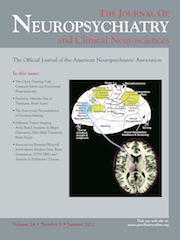The Use of Dexmedetomidine in Alcohol Withdrawal
To the Editor: Alcohol withdrawal (AW) increases noradrenergic neurotransmission and produces symptoms such as anxiety, agitation, elevated blood pressure, tachycardia, and tremor.1 Alpha-2 agonists, specifically clonidine and dexmedetomidine, may have a role in treating these specific symptom manifestations of AW.2 Dexmedetomidine has not been studied in AW, however case reports suggest an immediate and sustained effect with this agent in reducing signs and symptoms of AW.3–7 We present a case series describing clinical outcomes in five patients treated for AW with dexmedetomidine as adjunctive treatment to benzodiazepines in the critical care setting.
Case Series
All five patients were male with a mean age of 40.6±7.3 years. Patient cases were reviewed if the patient had a diagnosis of AW without another concurrent acute medical illness and were admitted to an intensive care unit. No patient had a positive blood alcohol level on admission. However, all patients had a past medical history of alcohol dependence and previous hospitalizations for AW. The mean length of ICU and hospital stays were 4.8±2.4 days and 11.4±3.6 days, respectively. No patients required intubation during hospitalization.
Dexmedetomidine was initiated after a mean of 1.6±0.9 days of treatment with benzodiazepines and was prescribed for a mean of 3±1 days. No patient received a loading dose and the infusion rate ranged between 0.04 mcg/kg/hr to 0.7 mcg/kg/hr. The mean rate of infusion based on a mean weight of 80.5±5.4 kg was 0.22±0.1 mcg/kg/hr.
Benzodiazepines were prescribed for approximately two days (mean 1.6±0.9 days), before dexmedetomidine initiation. The mean daily dose of benzodiazepines, in lorazepam equivalents, prior to the start of dexmedetomidine was 38.4±32.4 mg/d. Benzodiazepine usage increased following the start of dexmedetomidine to mean daily dose of 80.2±49.2 mg/d of lorazepam equivalents. However, total daily benzodiazepine amounts subsequently decreased for all, except for one patient, by day two of dexmedetomidine treatment. Following dexmedetomidine discontinuation, the total mean daily benzodiazepine dose decreased by 71% to a mean of 23.6±12.9 mg/d of lorazepam equivalents. Four patients showed a continued decrease in their benzodiazepine usage after dexmedetomidine discontinuation. The same one patient had a modest 9% increase in mean total daily benzodiazepine dose following dexmedetomidine discontinuation due to continued agitation.
No patients received concomitant medications for AW symptoms during dexmedetomidine treatment. The lowest daily Richmond Agitation Sedation Scale (RASS) scores during dexmedetomidine treatment ranged from -2 to -3 for all patients. Four of the five patients were placed in restraints prior to dexmedetomidine use, but these were discontinued following dexmedetomidine initiation.
There was little change in blood pressure during the time period we examined. There was an 18% decrease in mean heart rate, from 104±14.7 bpm to 85±8.9 bpm, following the initiation of dexmedetomidine.
Discussion
The adjunctive use of dexmedetomidine to benzodiazepines may have beneficial effects in reducing AW symptoms. In four of the five patients in this case series, dexmedetomidine may have reduced the need for high-doses of benzodiazepines, use of concomitant medications for agitation, RASS scores, and restraint use. One patient had persistent agitation following dexmedetomidine initiation and continued to require concomitant medications and restraints, it is unknown if this was due to the severity of AW, timing of dexmedetomidine initiation or other factors
Overall, there did not appear any adverse outcomes, such as over sedation or blood pressure changes, with dexmedetomidine use. There was an initial decrease in heart rate, however this might be expected since this medication is an α2 agonist. Lastly, there was no evidence of respiratory compromise associated with the combination of dexmedetomidine and high-dose benzodiazepines.
1 : The alcohol withdrawal syndrome. J Neurol Neurosurg Psychiatry 2008; 79:854–862Crossref, Medline, Google Scholar
2 : Role of α2-agonists in the treatment of acute alcohol withdrawal. Ann Pharmacother 2011; 45:649–657Crossref, Medline, Google Scholar
3 : Dexmedetomidine to facilitate drug withdrawal. Anesthesiology 2003; 98:575–577Crossref, Medline, Google Scholar
4 : Dexmedetomidine as an adjuvant in the treatment of alcohol withdrawal delirium: a case report. Gen Hosp Psychiatry 2006; 28:362–363Crossref, Medline, Google Scholar
5 : Dexmedetomidine infusion as adjunctive therapy to benzodiazepines for acute alcohol withdrawal. Ann Pharmacother 2008; 42:1703–1705Crossref, Medline, Google Scholar
6 : Dexmedetomidine for peri-operative sedation and analgesia in alcohol addiction. Anaesthesia 2006; 61:295–306Crossref, Medline, Google Scholar
7 : Dexmedetomidine controls agitation and facilitates reliable, serial neurological examinations in a non-intubated patient with traumatic brain injury. Neurocrit Care 2011; 15:175–181Crossref, Medline, Google Scholar



